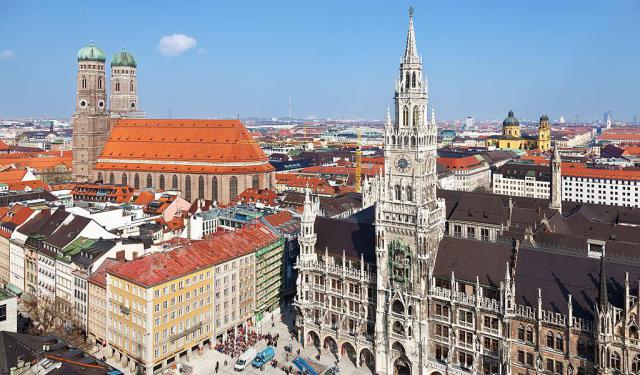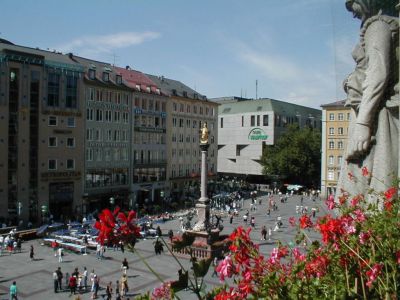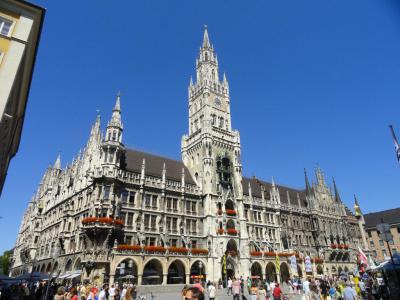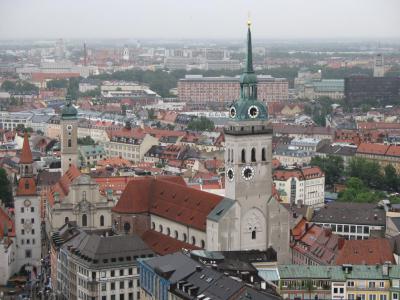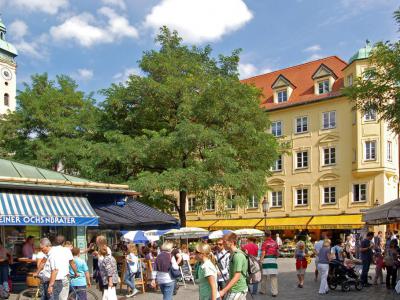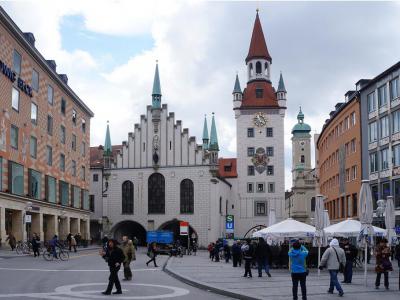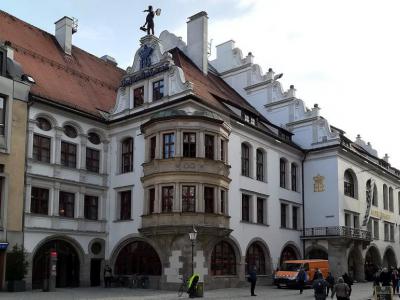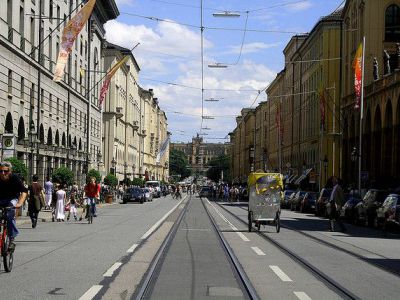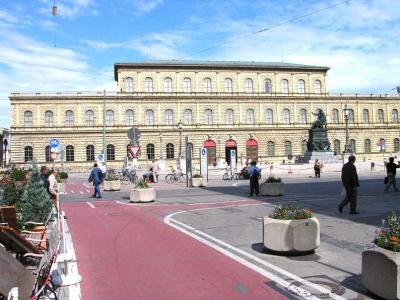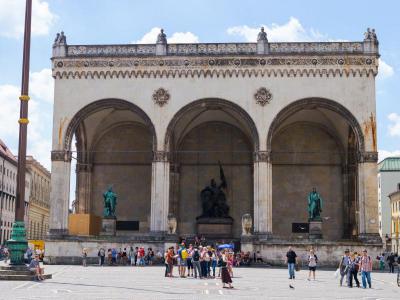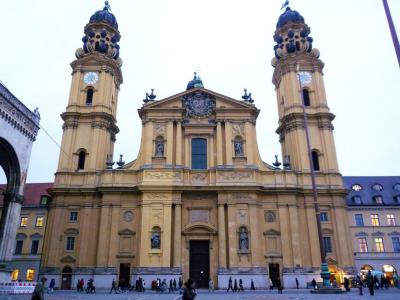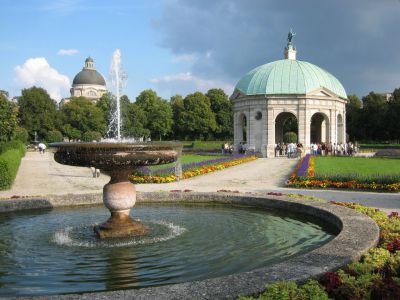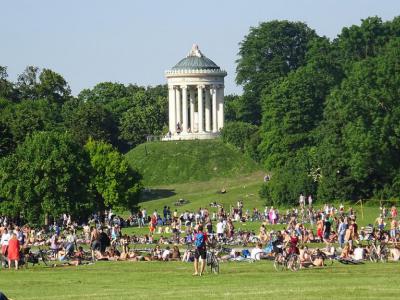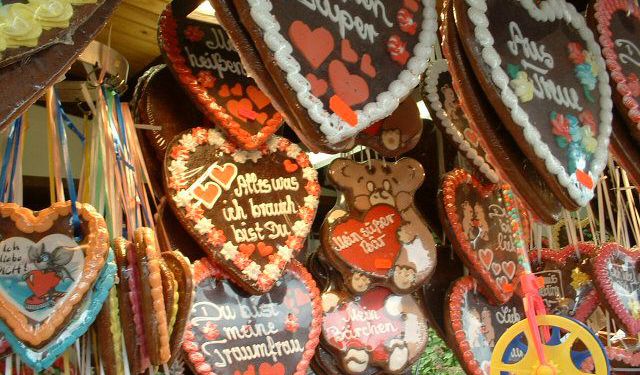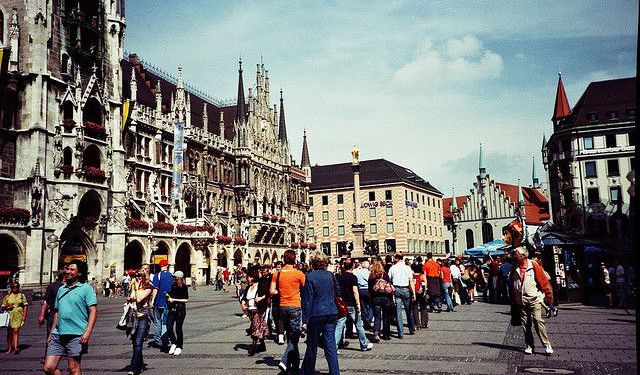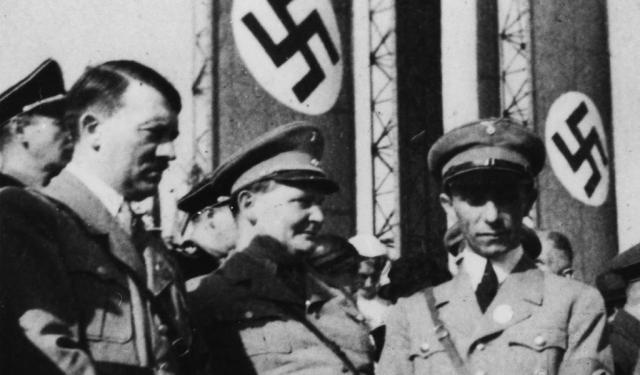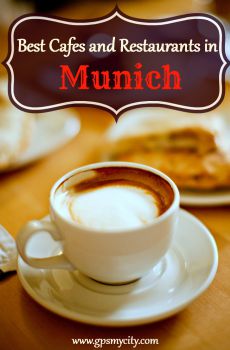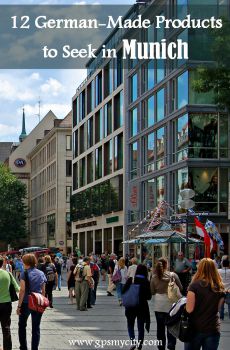Audio Guide: Munich Introduction Walking Tour (Self Guided), Munich
Set along the banks of the River Isar, just north of the Bavarian Alps, Munich is a city steeped in history, where centuries-old buildings meet a rich array of cultural landmarks and modern-day energy.
The first recorded mention dates back to 1158. The name is believed to come from the Old and Middle High German word “munichen”, meaning “by the monks.” It refers to the Benedictine monks who established a monastery in what would later become the city’s Old Town. Fittingly, a monk still appears on the city’s coat of arms.
When Bavaria became a sovereign kingdom in 1806, Munich quickly rose to prominence as a center for the arts, architecture, culture, and science. The early 20th century brought turbulence-after World War I, the city became a hotspot for political upheaval and was home to various factions, including the Nazi Party. Once in power, the regime declared Munich the “Capital of the Movement.”
Much of the city was destroyed during the Second World War, but its historic character was painstakingly restored. After the war and American occupation ended in 1949, Munich surged forward, experiencing rapid growth during the years of the so-called “economic miracle”. It later hosted the 1972 Summer Olympics and two FIFA World Cups.
Today, it’s a thriving hub of innovation and tradition. Known for its world-class museums, lively beer halls, and the famed Oktoberfest, this city offers something for every traveler. At its heart lies Mary’s Square, where the New Town Hall’s glockenspiel draws crowds with its charming chimes and animated figures.
So, if you're ready to discover more than just postcard views and you're curious about what history feels like beneath your feet-then set out on this self-guided walking tour. Let the streets lead you, let the city unfold, and let Munich speak for itself, one step at a time.
The first recorded mention dates back to 1158. The name is believed to come from the Old and Middle High German word “munichen”, meaning “by the monks.” It refers to the Benedictine monks who established a monastery in what would later become the city’s Old Town. Fittingly, a monk still appears on the city’s coat of arms.
When Bavaria became a sovereign kingdom in 1806, Munich quickly rose to prominence as a center for the arts, architecture, culture, and science. The early 20th century brought turbulence-after World War I, the city became a hotspot for political upheaval and was home to various factions, including the Nazi Party. Once in power, the regime declared Munich the “Capital of the Movement.”
Much of the city was destroyed during the Second World War, but its historic character was painstakingly restored. After the war and American occupation ended in 1949, Munich surged forward, experiencing rapid growth during the years of the so-called “economic miracle”. It later hosted the 1972 Summer Olympics and two FIFA World Cups.
Today, it’s a thriving hub of innovation and tradition. Known for its world-class museums, lively beer halls, and the famed Oktoberfest, this city offers something for every traveler. At its heart lies Mary’s Square, where the New Town Hall’s glockenspiel draws crowds with its charming chimes and animated figures.
So, if you're ready to discover more than just postcard views and you're curious about what history feels like beneath your feet-then set out on this self-guided walking tour. Let the streets lead you, let the city unfold, and let Munich speak for itself, one step at a time.
How it works: Download the app "GPSmyCity: Walks in 1K+ Cities" from Apple App Store or Google Play Store to your mobile phone or tablet. The app turns your mobile device into a personal tour guide and its built-in GPS navigation functions guide you from one tour stop to next. The app works offline, so no data plan is needed when traveling abroad.
Munich Introduction Walking Tour Map
Guide Name: Munich Introduction Walking Tour
Guide Location: Germany » Munich (See other walking tours in Munich)
Guide Type: Self-guided Walking Tour (Sightseeing)
# of Attractions: 12
Tour Duration: 2 Hour(s)
Travel Distance: 2.5 Km or 1.6 Miles
Author: DanaOffice
Sight(s) Featured in This Guide:
Guide Location: Germany » Munich (See other walking tours in Munich)
Guide Type: Self-guided Walking Tour (Sightseeing)
# of Attractions: 12
Tour Duration: 2 Hour(s)
Travel Distance: 2.5 Km or 1.6 Miles
Author: DanaOffice
Sight(s) Featured in This Guide:
- Marienplatz (Mary's Square)
- Neues Rathaus (New Town Hall)
- Peterskirche (St. Peter's Church)
- Viktualienmarkt (Farmer's Market)
- Altes Rathaus (Old Town Hall)
- Hofbrauhaus Beer Hall
- Maximilianstrasse (Maximilian Street)
- Residenz Royal Palace
- Feldherrnhalle (Field Marshall’s Hall)
- Theatinerkirche (Theatine Church)
- Hofgarten and War Memorial
- Englischer Garten (English Garden)
1) Marienplatz (Mary's Square) (must see)
Right in the center of Munich lies Mary’s Square, the city’s lively, historic core. Established back in 1158, it started out as a busy marketplace and a stage for medieval tournaments and public events. These days, it’s still the place where everything seems to converge-a perfect starting point for anyone exploring the city. Grand buildings rise on all sides, cafés spill onto the streets, and the square hums with energy from morning until night.
The star attraction is the New Town Hall, an elaborate neo-Gothic masterpiece brimming with stone figures, ornate carvings, and the famous Glockenspiel. At 11 a.m., noon, and again at 5 p.m. during the warmer months, the Glockenspiel puts on its quirky performance. Thirty-two mechanical figures spin into action, reenacting Bavarian legends to a soundtrack of bells and music. It’s theatrical, a little over-the-top, and completely delightful.
Across the square, you’ll also find the Old Town Hall, with its storybook tower and a toy museum tucked inside-great if you’re traveling with kids or just enjoy a touch of childhood nostalgia. Meanwhile in the center stands the Column of Saint Mary, raised in 1638 to mark the end of Swedish occupation during the Thirty Years' War. A gilded statue of the Virgin crowns the column-a quiet symbol in a bustling space, and the inspiration for the square’s name.
Street musicians, traditional restaurants, souvenir stalls-there’s always something happening around you. Want to shop? Stroll down Kaufinger Street, one of Munich’s busiest pedestrian avenues. If you’re more in the mood for architecture, the city’s Cathedral, with its distinctive twin domes, is just around the corner.
In short, Mary’s Square offers the perfect snapshot of Munich. Don’t rush through it-it’s a place to linger, look up, and let the city reveal itself one detail at a time.
The star attraction is the New Town Hall, an elaborate neo-Gothic masterpiece brimming with stone figures, ornate carvings, and the famous Glockenspiel. At 11 a.m., noon, and again at 5 p.m. during the warmer months, the Glockenspiel puts on its quirky performance. Thirty-two mechanical figures spin into action, reenacting Bavarian legends to a soundtrack of bells and music. It’s theatrical, a little over-the-top, and completely delightful.
Across the square, you’ll also find the Old Town Hall, with its storybook tower and a toy museum tucked inside-great if you’re traveling with kids or just enjoy a touch of childhood nostalgia. Meanwhile in the center stands the Column of Saint Mary, raised in 1638 to mark the end of Swedish occupation during the Thirty Years' War. A gilded statue of the Virgin crowns the column-a quiet symbol in a bustling space, and the inspiration for the square’s name.
Street musicians, traditional restaurants, souvenir stalls-there’s always something happening around you. Want to shop? Stroll down Kaufinger Street, one of Munich’s busiest pedestrian avenues. If you’re more in the mood for architecture, the city’s Cathedral, with its distinctive twin domes, is just around the corner.
In short, Mary’s Square offers the perfect snapshot of Munich. Don’t rush through it-it’s a place to linger, look up, and let the city reveal itself one detail at a time.
2) Neues Rathaus (New Town Hall) (must see)
In the second half of the 19th century, as Munich was growing rapidly and riding a wave of prosperity, city leaders decided they needed a new home for local government. The Old Town Hall had simply outgrown its purpose. They chose a prominent spot on the south side of Mary’s Square, cleared out around two dozen houses, and set the stage for something grand. Construction began in 1867 and continued all the way to 1909. Overseeing the project was a remarkably young architect-Georg Hauberrisser-just 24 when he started.
What emerged is a prime example of German pseudo-historical architecture-mock-Netherlands Gothic, to be exact. The building features six courtyards and a small garden at the back. Its façade is covered in intricate sculptures that reference Bavarian legends, local saints, and allegorical figures. At the top of the steeple stands a bronze statue of the “Munich Child,” the city’s traditional symbol. The tower also houses the fourth-largest chiming clock in Europe.
Every day, 43 bells ring out as copper figures dance in two scenes: a knightly tournament honoring the wedding of Duke Wilhelm V and Renata of Lorraine, and the legendary “Dance of the Coopers.” That dance, by the way, is still performed in the streets every seven years during Carnival to commemorate the passing of a plague epidemic in the early 1500s. Legend has it that coopers, loyal to the Duke, danced through the streets to inspire courage during tough times. The official dance moves were defined as far back as 1871.
The full carillon performance plays at 11 a.m., noon, and 5 p.m. in the summer, lasting up to 15 minutes depending on the day’s tune. As a whimsical finale, a tiny golden rooster perched above the clock lets out three soft chirps. And when evening falls, figures of a night watchman and the Angel of Peace appear in the upper windows, quietly blessing the “Munich Child” and the city below.
Visitors can ride the elevator to the viewing platform for sweeping views of the city. And beneath the building, the historic Ratskeller restaurant offers not just a good meal, but a truly atmospheric dining experience.
What emerged is a prime example of German pseudo-historical architecture-mock-Netherlands Gothic, to be exact. The building features six courtyards and a small garden at the back. Its façade is covered in intricate sculptures that reference Bavarian legends, local saints, and allegorical figures. At the top of the steeple stands a bronze statue of the “Munich Child,” the city’s traditional symbol. The tower also houses the fourth-largest chiming clock in Europe.
Every day, 43 bells ring out as copper figures dance in two scenes: a knightly tournament honoring the wedding of Duke Wilhelm V and Renata of Lorraine, and the legendary “Dance of the Coopers.” That dance, by the way, is still performed in the streets every seven years during Carnival to commemorate the passing of a plague epidemic in the early 1500s. Legend has it that coopers, loyal to the Duke, danced through the streets to inspire courage during tough times. The official dance moves were defined as far back as 1871.
The full carillon performance plays at 11 a.m., noon, and 5 p.m. in the summer, lasting up to 15 minutes depending on the day’s tune. As a whimsical finale, a tiny golden rooster perched above the clock lets out three soft chirps. And when evening falls, figures of a night watchman and the Angel of Peace appear in the upper windows, quietly blessing the “Munich Child” and the city below.
Visitors can ride the elevator to the viewing platform for sweeping views of the city. And beneath the building, the historic Ratskeller restaurant offers not just a good meal, but a truly atmospheric dining experience.
3) Peterskirche (St. Peter's Church) (must see)
Saint Peter’s Church rises from the highest point of Munich’s Old Town and holds the title of the city’s oldest public building. It played a key role in the city’s early development, with roots reaching back to the 12th century. In fact, the church was once part of the original monastery that gave the city its name-“ménchen” meaning “monks.” After the first structure was lost to fire, a new Gothic-style design took its place in the 13th century. Over time, the church evolved even further, getting a Baroque facelift in the 17th century and then a Rococo reimagining in the 18th. After World War II, major restoration work was carried out to return it to its former glory.
Step inside today, and you're met with an unexpectedly lavish interior. The high altar features a commanding statue of Saint Peter, surrounded by the Church Fathers, while the choir displays five intricately carved scenes from Peter’s life. Look closely and you may even spot the jeweled remains of Saint Mundita-an ornate, if somewhat haunting, presence.
The church’s tower, known as “Old Peter,” is another highlight. Equipped with eight clocks, seven bells, and a viewing gallery, it offers panoramic views over the city-and on clear days, even as far as the Alps. A set of color-coded markers on the lower platform helps gauge visibility; if you spot a white circle, it means you’re in luck. Climbing to the top is well worth the price, but be warned: it’s a steep ascent and not ideal for anyone with a fear of heights. For those who make it, two binocular viewers let you take in the rooftops, church spires, and skyline in vivid detail. And if you arrive before noon, you’ll get an unbeatable vantage point for watching the carillon perform over at Mary’s Square.
Step inside today, and you're met with an unexpectedly lavish interior. The high altar features a commanding statue of Saint Peter, surrounded by the Church Fathers, while the choir displays five intricately carved scenes from Peter’s life. Look closely and you may even spot the jeweled remains of Saint Mundita-an ornate, if somewhat haunting, presence.
The church’s tower, known as “Old Peter,” is another highlight. Equipped with eight clocks, seven bells, and a viewing gallery, it offers panoramic views over the city-and on clear days, even as far as the Alps. A set of color-coded markers on the lower platform helps gauge visibility; if you spot a white circle, it means you’re in luck. Climbing to the top is well worth the price, but be warned: it’s a steep ascent and not ideal for anyone with a fear of heights. For those who make it, two binocular viewers let you take in the rooftops, church spires, and skyline in vivid detail. And if you arrive before noon, you’ll get an unbeatable vantage point for watching the carillon perform over at Mary’s Square.
4) Viktualienmarkt (Farmer's Market) (must see)
Welcome to Munich’s oldest and most charming market. Since the early 1800s, it’s been the go-to spot for just about anything edible-fresh produce, dairy, meats, fine French wines, seafood, and rare delicacies from around the globe. Prices tend to be on the higher side, but the variety and quality are hard to beat. Of course, you’ll also find classic Bavarian favorites like pretzels, sausages, and local cheeses, all offering a true taste of the region.
People from all walks of life gather here-locals picking up ingredients for dinner, tourists exploring with wide eyes, and regulars who’ve made it part of their daily routine. Local customs involve eating white sausage, sipping hot soup, and enjoying a cold beer in one of the city’s most beloved beer gardens, set around a decorated maypole. Under the shade of chestnut trees, folks gather to sip cold brews and enjoy a break from the buzz.
But this market is more than a place to shop, drink or snack-it’s actually woven into Munich’s cultural identity. Throughout the year, it plays host to everything from folk dances and live music to seasonal festivals, and an especially lively Mardi Gras parade. The fountain erected to commemorate German cabaret artists emphasizes the spirit that has always animated this place.
In every sense, it’s a feast-for the senses, for the culture, and most definitely for the appetite.
People from all walks of life gather here-locals picking up ingredients for dinner, tourists exploring with wide eyes, and regulars who’ve made it part of their daily routine. Local customs involve eating white sausage, sipping hot soup, and enjoying a cold beer in one of the city’s most beloved beer gardens, set around a decorated maypole. Under the shade of chestnut trees, folks gather to sip cold brews and enjoy a break from the buzz.
But this market is more than a place to shop, drink or snack-it’s actually woven into Munich’s cultural identity. Throughout the year, it plays host to everything from folk dances and live music to seasonal festivals, and an especially lively Mardi Gras parade. The fountain erected to commemorate German cabaret artists emphasizes the spirit that has always animated this place.
In every sense, it’s a feast-for the senses, for the culture, and most definitely for the appetite.
5) Altes Rathaus (Old Town Hall)
Before the New Town Hall took over in 1874, the Old Town Hall was where Munich’s city government did its business. Unlike many buildings that were torn down to make way for the new structure, this one remained-preserved as a testament to the city’s commitment to restoration over replacement.
With its dove-grey façade, amber-tiled steeple, and delicate Gothic spires, the Hall captures the essence of its 15th-century origins-though what stands today isn’t an exact replica. Over time, additions like a baroque onion dome and later, an overly enthusiastic attempt at “regothification,” took the structure further from its medieval roots than what the current version reflects. Ironically, the faithful postwar reconstruction you see today may be closer to the spirit of the original than what existed before the Allied bombing.
The oldest surviving element is the 12th-century tower, once part of the city’s medieval fortifications. Today, it houses the Toy Museum, where you’ll find a charming collection of vintage toys-from antique train sets to miniature zoos-spread across four narrow floors connected by a spiral staircase. There's also a gift shop with hand-picked items that make for great souvenirs.
The ceremonial hall still retains its Gothic grandeur, with broad wooden barrel vaults and a frieze of 96 coats of arms lining one wall. Meanwhile, on the building’s side, there's a whimsical surprise: a bronze statue of Shakespeare’s Juliet, a gift from the city of Verona in the 1970s.
But the building also carries a darker legacy. In 1938, Nazi propaganda minister Joseph Goebbels delivered a speech here that triggered the “Night of Broken Glass.” That night of terror saw synagogues burned, Jewish businesses destroyed, and thousands arrested. It’s widely seen as the moment when Nazi anti-Semitic violence escalated into what became the Holocaust.
With its dove-grey façade, amber-tiled steeple, and delicate Gothic spires, the Hall captures the essence of its 15th-century origins-though what stands today isn’t an exact replica. Over time, additions like a baroque onion dome and later, an overly enthusiastic attempt at “regothification,” took the structure further from its medieval roots than what the current version reflects. Ironically, the faithful postwar reconstruction you see today may be closer to the spirit of the original than what existed before the Allied bombing.
The oldest surviving element is the 12th-century tower, once part of the city’s medieval fortifications. Today, it houses the Toy Museum, where you’ll find a charming collection of vintage toys-from antique train sets to miniature zoos-spread across four narrow floors connected by a spiral staircase. There's also a gift shop with hand-picked items that make for great souvenirs.
The ceremonial hall still retains its Gothic grandeur, with broad wooden barrel vaults and a frieze of 96 coats of arms lining one wall. Meanwhile, on the building’s side, there's a whimsical surprise: a bronze statue of Shakespeare’s Juliet, a gift from the city of Verona in the 1970s.
But the building also carries a darker legacy. In 1938, Nazi propaganda minister Joseph Goebbels delivered a speech here that triggered the “Night of Broken Glass.” That night of terror saw synagogues burned, Jewish businesses destroyed, and thousands arrested. It’s widely seen as the moment when Nazi anti-Semitic violence escalated into what became the Holocaust.
6) Hofbrauhaus Beer Hall (must see)
Arguably the most famous ‘watering hole’ in Munich, this spot is the embodiment of Bavarian tradition and spirit. Its story began in 1589, founded as part of the Royal Brewery by Wilhelm V. Back then, it wasn’t even open to the public-reserved instead for royal use. That changed in 1828, when the doors were finally thrown open to everyone. Today, it's among the city’s most beloved gathering places, steeped in old-world charm.
On the ground floor, long tables fill the hall that can hold 1,000 drinkers while bands belt out folk tunes. The menu is full of Bavarian classics, and the atmosphere is pure celebration. Upstairs, a vaulted ceremonial hall can seat another 1,300 people, with additional side rooms for smaller gatherings. And when the weather’s warm, the beer garden becomes a favorite hangout-with its shady chestnut trees, bubbling fountain, and relaxed outdoor vibe. On a typical day, around 10,000 liters of beer are served here-that’s over 17,000 pints.
True to tradition, the beer follows the Bavarian Beer Purity Law of 1516, which allows only natural ingredients. That standard is still upheld across the city, and the brews here are no exception-crafted with care and full of flavor.
But not all of the building’s history is festive. On February 24, 1920, Adolf Hitler stood here to announce the official program of the then-fledgling Nazi Party. Just over a year later, on July 29, 1921, he was elected as the Party’s leader-right in this very hall. So while the beer house is rightly remembered for joy, music, and beer, it also witnessed one of the more sobering moments of 20th-century history.
On the ground floor, long tables fill the hall that can hold 1,000 drinkers while bands belt out folk tunes. The menu is full of Bavarian classics, and the atmosphere is pure celebration. Upstairs, a vaulted ceremonial hall can seat another 1,300 people, with additional side rooms for smaller gatherings. And when the weather’s warm, the beer garden becomes a favorite hangout-with its shady chestnut trees, bubbling fountain, and relaxed outdoor vibe. On a typical day, around 10,000 liters of beer are served here-that’s over 17,000 pints.
True to tradition, the beer follows the Bavarian Beer Purity Law of 1516, which allows only natural ingredients. That standard is still upheld across the city, and the brews here are no exception-crafted with care and full of flavor.
But not all of the building’s history is festive. On February 24, 1920, Adolf Hitler stood here to announce the official program of the then-fledgling Nazi Party. Just over a year later, on July 29, 1921, he was elected as the Party’s leader-right in this very hall. So while the beer house is rightly remembered for joy, music, and beer, it also witnessed one of the more sobering moments of 20th-century history.
7) Maximilianstrasse (Maximilian Street)
Stretching through the heart of Munich, Maximilian Street is one of the city’s grandest avenues, conceived in 1850 under the patronage of King Maximilian II of Bavaria. His vision lives on not just in name, but in the street’s very design. Maximilian set out to create a new architectural style that fused historic influences with modern construction techniques-and the result is a showcase of Neo-Gothic architecture, heavily inspired by the English Perpendicular style.
As part of the transformation, even the north façade of the Old Mint Yard was redesigned to match this aesthetic. Along the route, you’ll come across other prominent institutions: the Munich Chamber Theatre, the Upper Bavaria Government Building, the Museum of Ethnology, or the Wilhelm Grammar School.
Things take a more luxurious turn toward the western section of the boulevard. This part is all about high-end shopping and upscale living-home to art galleries, fine jewelers, luxury boutiques, and the 5-star Hotel Kempinski. Brands like Chanel, Gucci, Dior, Bulgari, and Versace dominate the storefronts, turning this stretch into one of the priciest retail areas in all of Germany.
Another striking feature is the Maximiliansbridge, built in the mid-19th century and topped with a statue of Pallas Athene. Cross it, and you’re led straight to Maximilianeum-the imposing, palatial seat of the Bavarian State Parliament.
As part of the transformation, even the north façade of the Old Mint Yard was redesigned to match this aesthetic. Along the route, you’ll come across other prominent institutions: the Munich Chamber Theatre, the Upper Bavaria Government Building, the Museum of Ethnology, or the Wilhelm Grammar School.
Things take a more luxurious turn toward the western section of the boulevard. This part is all about high-end shopping and upscale living-home to art galleries, fine jewelers, luxury boutiques, and the 5-star Hotel Kempinski. Brands like Chanel, Gucci, Dior, Bulgari, and Versace dominate the storefronts, turning this stretch into one of the priciest retail areas in all of Germany.
Another striking feature is the Maximiliansbridge, built in the mid-19th century and topped with a statue of Pallas Athene. Cross it, and you’re led straight to Maximilianeum-the imposing, palatial seat of the Bavarian State Parliament.
8) Residenz Royal Palace (must see)
The Residenz was the home of Bavaria’s Wittelsbach dynasty all the way up until 1918. With its gilded grandeur and Versailles-like scale, this royal palace complex ranks among Europe’s most impressive, and a throrough exploration could easily take a few days. It’s massive to begin with, and even larger now that more rooms and passageways have been restored and opened to the public.
A good place to start is outside, with the three imposing facades and a series of stunning courtyards, many of which are freely accessible. From there, you can step into the Residenz Museum itself, as well as the Cuvilliés-arguably the finest Rococo theater in Europe, and the Treasure Chamber, where you’ll find a glittering display of jewels, gold, silver, crystal, and enamelwork-collected over a thousand years.
There’s a huge amount to see in the 10 courtyards and nearly 130 rooms, halls and galleries. Among the standout highlights is the Gallery of the Ancestors, where you’ll meet 121 members of the Wittelsbach family; the Antiquarium-the largest Renaissance hall north of the Alps; the extensive porcelain collections, including an array of pieces from France, England, Germany, Japan, and China; and the lavish State Rooms, where German Rococo reaches its decorative peak, especially in the Green Gallery and the Cabinet of Mirrors. Oh, and don’t miss the Grottenhof courtyard, known for its elegant arcade and bronze fountain of Perseus.
For the full experience, consider a combined ticket that includes the Museum, the Theatre and the Treasury. And if you want to tailor your visit, the audio guide lets you jump straight to the rooms, artworks, or stories that interest you most.
A good place to start is outside, with the three imposing facades and a series of stunning courtyards, many of which are freely accessible. From there, you can step into the Residenz Museum itself, as well as the Cuvilliés-arguably the finest Rococo theater in Europe, and the Treasure Chamber, where you’ll find a glittering display of jewels, gold, silver, crystal, and enamelwork-collected over a thousand years.
There’s a huge amount to see in the 10 courtyards and nearly 130 rooms, halls and galleries. Among the standout highlights is the Gallery of the Ancestors, where you’ll meet 121 members of the Wittelsbach family; the Antiquarium-the largest Renaissance hall north of the Alps; the extensive porcelain collections, including an array of pieces from France, England, Germany, Japan, and China; and the lavish State Rooms, where German Rococo reaches its decorative peak, especially in the Green Gallery and the Cabinet of Mirrors. Oh, and don’t miss the Grottenhof courtyard, known for its elegant arcade and bronze fountain of Perseus.
For the full experience, consider a combined ticket that includes the Museum, the Theatre and the Treasury. And if you want to tailor your visit, the audio guide lets you jump straight to the rooms, artworks, or stories that interest you most.
9) Feldherrnhalle (Field Marshall’s Hall)
The Field Marshal's Hall is a grand open-air loggia built to honor Bavaria’s military leaders and the soldiers who died in the Franco-Prussian War. Commissioned by King Ludwig I in the 1840s, it was constructed on the site of a former city gate. The design was inspired by Florence’s famous Loggia dei Lanzi, bringing a touch of Italian grandeur to Munich’s historic center.
Standing at the front are two imposing bronze statues commemorating key figures in Bavarian military history: Count Tilly, who played a major role during the Thirty Years’ War, and Count von Wrede, a marshal from the Napoleonic era. In 1882, a third sculpture was added at the center-this one celebrating the Bavarian army’s role in the Franco-Prussian War. As you approach, you’ll also spot two lion statues at the steps, crafted in 1906. One, mouth open, faces the Residenz Royal Palace; the other, with mouth closed, looks toward the nearby church.
Yet for many, the site is remembered most for the dramatic events of 1923. That year, during the failed Beer Hall Putsch, Adolf Hitler led around 2,000 followers in an attempted coup, marching toward the center of Munich in what he called a “people’s revolution.” They were met by the Bavarian police in front of this very loggia. A deadly confrontation followed-four officers and sixteen insurgents were killed. Hitler was arrested shortly after and imprisoned. A decade later, after coming to power, he elevated the failed revolt into a cornerstone of the Nazi cult.
Standing at the front are two imposing bronze statues commemorating key figures in Bavarian military history: Count Tilly, who played a major role during the Thirty Years’ War, and Count von Wrede, a marshal from the Napoleonic era. In 1882, a third sculpture was added at the center-this one celebrating the Bavarian army’s role in the Franco-Prussian War. As you approach, you’ll also spot two lion statues at the steps, crafted in 1906. One, mouth open, faces the Residenz Royal Palace; the other, with mouth closed, looks toward the nearby church.
Yet for many, the site is remembered most for the dramatic events of 1923. That year, during the failed Beer Hall Putsch, Adolf Hitler led around 2,000 followers in an attempted coup, marching toward the center of Munich in what he called a “people’s revolution.” They were met by the Bavarian police in front of this very loggia. A deadly confrontation followed-four officers and sixteen insurgents were killed. Hitler was arrested shortly after and imprisoned. A decade later, after coming to power, he elevated the failed revolt into a cornerstone of the Nazi cult.
10) Theatinerkirche (Theatine Church)
In 1662, to celebrate the long-awaited birth of their son and heir, Elector Ferdinand and his wife, Henriette of Savoy, commissioned the construction of a church and monastery for the Italian Theatine order. The task fell to Antonio Barelli of Bologna, who envisioned nothing less than the most ornate and splendid temple imaginable. He based his design on Sant’Andrea della Valle in Rome, bringing a piece of pure Roman Baroque to the heart of Munich.
Bathed in sun-washed yellow-orange and radiating a bright Mediterranean vibe, the church instantly stood out in the city’s skyline. Its distinctive style brought a fresh twist to Munich’s architecture and went on to inspire many church designs across Southern Germany.
The soaring domes reach up to 70 meters and echo the curves and scrolls of Venice’s Santa Maria della Salute. The façade, richly sculpted in late Baroque style, steps forward in dramatic layers, with pilasters, scrolling cornices, and niches containing statues of Ferdinand and Henriette, their son Maximilian, and Saint Cajetan, the church’s patron. Just above the entrance, a cartouche displays coats of arms, including those of Bavaria and Saxony.
Among Munich’s many richly decorated churches, this one is remarkable for its radiant white interior, which seems to glow in natural light. Intricate stuccowork fills the space, with allegorical figures and playful cherubs adding drama and charm. The main altar is flanked by twisted columns, drawing the eye upward, while below, the crypt houses the tombs of Bavarian dukes and kings-including the church’s founders, their son Maximilian Emanuel, and his wife. It’s a place where architectural splendor and dynastic history intertwine.
Bathed in sun-washed yellow-orange and radiating a bright Mediterranean vibe, the church instantly stood out in the city’s skyline. Its distinctive style brought a fresh twist to Munich’s architecture and went on to inspire many church designs across Southern Germany.
The soaring domes reach up to 70 meters and echo the curves and scrolls of Venice’s Santa Maria della Salute. The façade, richly sculpted in late Baroque style, steps forward in dramatic layers, with pilasters, scrolling cornices, and niches containing statues of Ferdinand and Henriette, their son Maximilian, and Saint Cajetan, the church’s patron. Just above the entrance, a cartouche displays coats of arms, including those of Bavaria and Saxony.
Among Munich’s many richly decorated churches, this one is remarkable for its radiant white interior, which seems to glow in natural light. Intricate stuccowork fills the space, with allegorical figures and playful cherubs adding drama and charm. The main altar is flanked by twisted columns, drawing the eye upward, while below, the crypt houses the tombs of Bavarian dukes and kings-including the church’s founders, their son Maximilian Emanuel, and his wife. It’s a place where architectural splendor and dynastic history intertwine.
11) Hofgarten and War Memorial
The Hofgarten is a peaceful, geometrically designed retreat-and one of the largest Mannerist gardens to be found north of the Alps. Originally laid out in the early 1600s, it is arranged around two straight main paths that cross at right angles. At their intersection stands the Temple of Diana, an elegant polygonal pavilion crowned with a bronze figure representing Bavaria. Lining the edges of the garden are arcades that now house art galleries and cafés, their walls adorned with frescoes depicting historic moments from the Wittelsbach dynasty.
True to its 17th-century roots, the Hofgarten has been thoughtfully restored, with chestnut trees, flowerbeds, and fountains arranged just as the original plans intended. Tucked into the northeast corner is a striking black granite monument honoring the White Rose group-a circle of philosophy students who dared to resist the Nazi regime through non-violent means. After an unjust trial, they were executed, but their legacy lives on here in quiet remembrance. The garden also finds mention in T.S. Eliot’s “The Waste Land”, widely regarded as one of the most important English-language poems of the 20th century. In the poem, it serves a symbol of fading aristocracy and the spiritual emptiness that followed Europe’s royal decline.
At the eastern edge of the grounds, you’ll come across another poignant tribute-a memorial to Munich’s fallen from World War I. Within a rectangular enclosure lies an open crypt holding the statue of a fallen soldier. Inaugurated in 1924 by Crown Prince Rupprecht of Bavaria, the monument has since been recognized as a cultural landmark.
True to its 17th-century roots, the Hofgarten has been thoughtfully restored, with chestnut trees, flowerbeds, and fountains arranged just as the original plans intended. Tucked into the northeast corner is a striking black granite monument honoring the White Rose group-a circle of philosophy students who dared to resist the Nazi regime through non-violent means. After an unjust trial, they were executed, but their legacy lives on here in quiet remembrance. The garden also finds mention in T.S. Eliot’s “The Waste Land”, widely regarded as one of the most important English-language poems of the 20th century. In the poem, it serves a symbol of fading aristocracy and the spiritual emptiness that followed Europe’s royal decline.
At the eastern edge of the grounds, you’ll come across another poignant tribute-a memorial to Munich’s fallen from World War I. Within a rectangular enclosure lies an open crypt holding the statue of a fallen soldier. Inaugurated in 1924 by Crown Prince Rupprecht of Bavaria, the monument has since been recognized as a cultural landmark.
12) Englischer Garten (English Garden) (must see)
Munich’s English Garden is the largest publicly owned park in Europe-and even larger than New York’s Central Park, stretching across an impressive 900 acres, or about three and a half kilometers. The idea came from Archduke Carl Theodore, but it was brought to life by Benjamin Thompson, an American-born British physicist who later became known as Count Rumford.
Once a royal hunting ground for the Wittelsbach family, the land was transformed into a public park in 1792, stretching three miles along the scenic Isar River. Its name comes from the informal landscaping style that mirrors the naturalistic English gardens popular in the 18th and 19th centuries.
Today, the English Garden is a favorite escape for locals-perfect for relaxing, playing sports, or catching up with friends. For the more adventurous, nude sunbathing is also allowed. You’ll find countless paths, riverside spots to cool your feet or go for a swim, as well as live music in the warmer months, and plenty of food options.
Among standout attractions is the Eisbach wave, an artificial surfing spot that’s active year-round, drawing spectators and surfers alike. In summer, make your way to one of the four beer gardens, especially the one near the Chinese Tower. There, you can enjoy a cold draft beer to the sound of traditional Bavarian tunes.
Within the park, you’ll also find a monument to Count Rumford, a serene Japanese Garden created for the Munich Olympics, the elegant Monopteros temple, and an amphitheater tucked away toward the northern edge.
Tip: Sunday’s the big walking day. With most shops closed, locals flood the park-so if you're in town, lace up your shoes and join the crowd. Just keep an eye out for cyclists-they tend to zip by when you least expect it. And if you're planning to swim or surf, don’t forget your gear.
Once a royal hunting ground for the Wittelsbach family, the land was transformed into a public park in 1792, stretching three miles along the scenic Isar River. Its name comes from the informal landscaping style that mirrors the naturalistic English gardens popular in the 18th and 19th centuries.
Today, the English Garden is a favorite escape for locals-perfect for relaxing, playing sports, or catching up with friends. For the more adventurous, nude sunbathing is also allowed. You’ll find countless paths, riverside spots to cool your feet or go for a swim, as well as live music in the warmer months, and plenty of food options.
Among standout attractions is the Eisbach wave, an artificial surfing spot that’s active year-round, drawing spectators and surfers alike. In summer, make your way to one of the four beer gardens, especially the one near the Chinese Tower. There, you can enjoy a cold draft beer to the sound of traditional Bavarian tunes.
Within the park, you’ll also find a monument to Count Rumford, a serene Japanese Garden created for the Munich Olympics, the elegant Monopteros temple, and an amphitheater tucked away toward the northern edge.
Tip: Sunday’s the big walking day. With most shops closed, locals flood the park-so if you're in town, lace up your shoes and join the crowd. Just keep an eye out for cyclists-they tend to zip by when you least expect it. And if you're planning to swim or surf, don’t forget your gear.
Walking Tours in Munich, Germany
Create Your Own Walk in Munich
Creating your own self-guided walk in Munich is easy and fun. Choose the city attractions that you want to see and a walk route map will be created just for you. You can even set your hotel as the start point of the walk.
Old Town Souvenir Shops
"Collect moments, not things," wise men say. In reference to travel, this may be interpreted as the prevalence of experiences and memories over material gains. Still, when it comes to travel mementos, albeit material they are, memories and experiences are primarily what these little (or not so little) tokens are all about.
And it would be a pity to leave Munich without bringing home... view more
Tour Duration: 1 Hour(s)
Travel Distance: 1.5 Km or 0.9 Miles
And it would be a pity to leave Munich without bringing home... view more
Tour Duration: 1 Hour(s)
Travel Distance: 1.5 Km or 0.9 Miles
Old Town Walking Tour
Munich’s Old Town, known as the Altstadt, unfolds across the western bank of the River Isar-a captivating blend of medieval charm, architectural brilliance, and deep cultural roots. As the historic heart of the Bavarian capital, it’s more than just a preserved district-it is is listed as a historical monument and is a living museum – “where the past harmonizes with the present in a grand... view more
Tour Duration: 2 Hour(s)
Travel Distance: 2.7 Km or 1.7 Miles
Tour Duration: 2 Hour(s)
Travel Distance: 2.7 Km or 1.7 Miles
Third Reich Munich Walking Tour
In the early decades of the 20th century, Munich became the birthplace of one of history’s darkest political movements. Long before the world knew what was coming, Bavaria’s capital had already laid the groundwork for the rise of the National Socialist German Workers' Party-better known as the Nazi Party.
From 1933 to 1945, the Third Reich took hold of Germany under Adolf Hitler’s... view more
Tour Duration: 2 Hour(s)
Travel Distance: 3.3 Km or 2.1 Miles
From 1933 to 1945, the Third Reich took hold of Germany under Adolf Hitler’s... view more
Tour Duration: 2 Hour(s)
Travel Distance: 3.3 Km or 2.1 Miles
Useful Travel Guides for Planning Your Trip
Top 10 Cafes and Restaurants in Munich
While there are many restaurants and cafes in downtown Munich for a visitor to choose from, by far not all of them are truly worth visiting. Here's the solid list of quality cafes and restaurants that will add greatly to your Munich experience. Each restaurant and cafe featured here offers...
12 German-Made Things to Buy in Munich
The Bavarian capital Munich, much as the whole state of Bavaria, form an inseparable part of the German image, although a very unique part in its difference to the rest of the country, including the language. Bavarian beer occupies an important place in German heritage, from the infamous 1920s Beer...
The Most Popular Cities
/ view all
